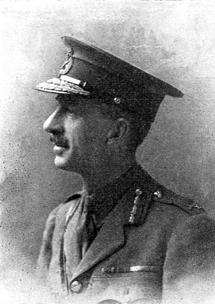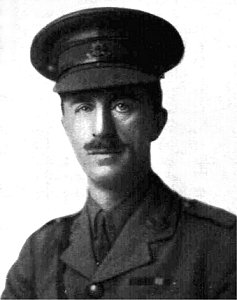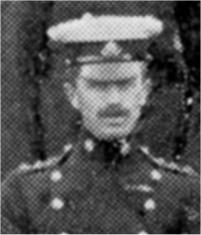Birgadier-General Edward Barnard HANKEY, C.B., D.S.O.
Commanded the 2nd Battalion Worcestershire Regiment from September 1914 to December 1914
Commanded the 3rd Battalion Worcestershire Regiment from August 1915 to November 1915
Edward Barnard Hankey was born at Fetcham Rectory, Surrey in 1875, son of John Barnard Hankey who was a J.P. for Surrey. He was educated at Eton College. Edward was commissioned into the Worcestershire Regiment on 7th December 1895, and joined the 2nd Battalion in Malta in 1896. During the South African War, Lieutenant Hankey (as he then was) served with the 2nd Battalion in operations in the Orange River Colony. He took an active and distinguished part in the battle of Slingersfontein on 12th February 1900. Later at Middlefontein where the Battalion was rear guard to a large convoy bound for Rustenburg, "D" Company succeeded in driving off the Boers who had ambushed the convoy and restored a tricky situation. Hankey was seriously wounded in this action. He was warded the Queen's South African Medal with four clasps. After South Africa, in July 1902, he was seconded to the Egyptian Army and served for two years. During this time he participated in the Jerok Expedition in the Southern Sudan under the then Lieutenant-Colonel George Gorringe. In 1905 he was a Captain in the 3rd Battalion Worcestershire Regiment at Aldershot. In 1906 Hankey took up an appointment as ADC to the Governor of Western Australia - in which capacity he served until December 1907. From 1910 to the outbreak of the war he was on home service with the Worcestershire Regiment. |
Brig.-General E. B. Hankey |
He was 2 i/c 2nd Worcesters when it went to France as part of the BEF, and became battalion commander on the Aisne in September 1914. During First Ypres, he led the famous charge of the 2nd Worcesters at Gheluvelt on 31 October 1914.
In the middle of September 1914, Major Hankey (as he was then) assumed command of the 2nd Battalion during the most critical time of the battle of the Aisne when the Battalion was much to the fore and suffering heavy casualties, mostly due to a local counter attack in order to restore a situation on the front of a neighbouring Brigade.
E. B. Hankey |
After the battle of the Aisne the 2nd Battalion Worcestershire Regiment was transferred to the Belgian front with the remainder of the 2nd Division. There on the Ypres front they were heavily engaged from 21st October to 21st November 1914. On the 21st October 1914, as Advanced Guard, they met the Germans in force. After fighting all day neither side were able to advance. The Battalion dug in during the night as did the troops on their right and left, thereby forming what was to become part of the famous Ypres Salient. On the 24th October 1914 the 2nd Battalion was called upon to make an immediate counter attack in order to restore the situation in the Polygon Wood, where the Germans had broken through the remnants of the 7th Division. They succeeded in clearing the forest and re-establishing the line. It was a difficult and severe fight, and they had very heavy casualties indeed. Then on 31st October 1914 came the famous counter attack at Gheluvelt when the Battalion, already reduced to half-strength, was once more called upon to save an extremely critical situation. As is well known the 2nd Battalion was successful and made history. The Battalion suffered severely and was consequently reduced to little more than a skeleton Battalion. Major Hankey himself led this attack and was an inspiration to us all. During November 1914 there were other minor engagements under severe winter conditions. Finally on 22nd November 1914, the 2nd Battalion was relieved and withdrew to Bailleul for well-earned rest and to be made up to strength. A month later the Battalion moved to a new front and took over the line from Indian Troops in the vicinity of Richbourg. There on the 30th December 1914, Major Hankey was severely wounded and much to the regret of us all left the Battalion for good. |
It will be seen from the report that during his command the 2nd Battalion went through strenuous and critical times. They were indeed extremely fortunate to have such a man in command at such a time. Throughout, by his cool courage and determination, he set a very fine example to all. His sound judgement and calm manner at all times was the greatest help and encouragement to those who were fortunate enough to serve under him. In spite of all, he managed to keep his quiet sense of humour and great charm.
After recovering from his wounds, Hankey commanded 3rd Battalion Worcestershire Regiment from August to November 1915. He was then graded a Staff Captain for Instructional and Special Duties from February 1916 until he assumed command of the newly-formed ‘G’ Battalion, Heavy Branch Machine Gun Corps (later 7th Battalion Tank Corps) in November 1916. The battalion participated in the Battle of Pilckem Ridge on 31st July 1917, when it worked well in co-operation with the infantry of the 51st and 39th Divisions (largely, in Hankey’s opinion, thanks to an opportunity to train beforehand with the units concerned), and made the remarkably successful attack on 19th August against the Cockcroft. It later took part in the Cambrai operations. Hankey commanded the battalion until January 1918 when he became G.O.C. 4th Tank Brigade - becoming a Brigadier-General on 20th April 1918. He held this command until two days before the end of the war, when Brigadier-General John Micklem succeeded him. After the war, Hankey was appointed to command No. 3 Tank Group in the Army of Occupation.
General Hankey was made a Freeman of the City of Worcester in 1917. In 1919 he commanded a Tank Group on the Rhine, and in December 1920 he became commander of 2nd Tank Battalion. In 1923 successively Commandant Royal Tank Corps Centre Bovington Camp, Dorset, and Inspector R.T.C. at the War Office. In October 1925 he was appointed G.O.C. 12th Infantry Brigade, Eastern Command, a post he held until retirement in 1929. In addition to the D.S.O., which he won at Ypres in 1917, General Hankey was created a Commander of the Bath in 1927. He was awarded the Croix de Guerre and was three times mentioned in despatches. He was also presented with the freedom of the city of Worcester in the form a silver tank in 1917. General Edward B. Hankey, died at his home in Cirencester on 22nd March 1959, aged 83. His funeral, which was private, was attended by Brigadier B. C. S. Clarke, who was his Adjutant at Gheluvelt, and by Captain R. A. U. Richards from the Depot.
|
E. B. Hankey |



